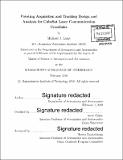Pointing acquisition and tracking design and analysis for CubeSat Laser communication
Author(s)
Long, Michael J. (Michael Joseph)
DownloadFull printable version (24.61Mb)
Other Contributors
Massachusetts Institute of Technology. Department of Aeronautics and Astronautics.
Advisor
Kerri Cahoy.
Terms of use
Metadata
Show full item recordAbstract
This thesis proposes a low size, weight, and power (SWaP) laser communication pointing, acquisition, and tracking (PAT) design for CubeSats in low earth orbit (LEO). As data production on-orbit continues to grow due to sensor miniaturization and the increased prevalence of satellites in LEO, current RF communication systems struggle to meet the data routing demands on resource constrained platforms. Laser communication provides an attractive alternative with reduced regulatory constraints and efficient use of available SWaP, but introduces the new challenge of stringent pointing requirements. The approach in this thesis is to survey historic capable laser communication space systems and identify PAT methods and designs that can be used or adapted for nano/microsatellite class applications. The CubeSat Lasercom Infrared CrosslinK (CLICK) experiment is a particular case study that is the focus of this thesis. This thesis develops a PAT sequence for CLICK as well as designs and analyzes the optical system. CLICK's mission is to provide full-duplex laser communication between two 3U CubeSats in the same LEO orbital plane at data rates >20 Mbps and separation distances from 10 km to 850 km. A 1.5U laser communication payload with a 3-stage PAT sequence is developed and each stage is characterized by identifying, analyzing, and combining the individual error terms to yield a probabilistic pointing distribution for each stage. Based on the analysis input assumptions and results, a preliminary design is generated by sizing and selecting critical components and flowing down subsystem and bus requirements for further program development. The open loop budget analysis predicts that the pointing error will fall within a 2100 arcsecond full angle cone 99.9% of the time. The beacon laser divergence angle and beacon camera field of view (FOV) are conservatively sized to 0.75° full width half max (FWHM) and ±10°, respectively, to accommodate a stare-stare acquisition. The overall pointing capability of the system is predicted to be <14.6 arcseconds 99.8% of the time when a payload temperature of ±5°C relative to equilibrium is maintained. This work contributes to the development of the first CubeSat laser communication crosslink, a communication channel historically only implemented by larger, more expensive systems.
Description
Thesis: S.M., Massachusetts Institute of Technology, Department of Aeronautics and Astronautics, 2018. Cataloged from PDF version of thesis. Includes bibliographical references (pages 145-148).
Date issued
2018Department
Massachusetts Institute of Technology. Department of Aeronautics and AstronauticsPublisher
Massachusetts Institute of Technology
Keywords
Aeronautics and Astronautics.